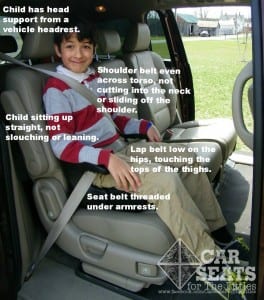We’re thrilled to see more laws in more states align closer to best practice. As of January 1, 2017, California joined the states with laws requiring children to remain rear facing in their car seats until at least 2 years of age. On that day, California also adopted a law banning all cell phones from being held by the driver.
When the new law took effect, all children in California under age 2 must ride rear facing in the vehicle. The only exceptions are rarely seen — children who are under 2 years old and weigh more than 40 pounds or are taller than 40 inches.
Why Rear Facing is Important

Evenflo SafeMax: 2 years old, 28 lbs, 36 inches tall
Rear facing is 5 times safer for children who are between 1 and 2 years old.
You read that right!
Rear Facing is Significantly Safer
When children ride rear facing, instead of their head flying forward in a crash, the child’s head, neck, and back will be supported by the car seat. The rear facing child’s head is cradled in the car seat as the crash forces disperse around them, reducing the amount of pressure put on the child’s undeveloped spine.
Rear Facing Past Two Years Old

This long legged 4 year old is quite comfortable rear facing
At CSFTL, we advocate that children ride rear facing as long as possible. Ideally, that’s until some time around the child’s fourth birthday. Many convertible and multimode car seats on the market today have high enough height and weight limits that most children will fit comfortably until they turn four.
While age 2 is the minimum recommended age to keep children facing the rear of the vehicle, the AAP and NHTSA both recommend that children ride rear facing until they’ve grown to the height and weight limits of their car seat. We recommend that, too!
California Booster Seat Law

This 10 year old Californian doesn’t pass the Five Step Test yet
The California law has not changed for booster seats. Children who are age 8 or older may use the vehicle seat belt only if it fits properly. Here’s what that means:
- The vehicle’s lap belt sits low on the child’s hips
- The vehicle’s lap belt touches the child’s upper thighs
- The vehicle’s shoulder belt crosses the center of the child’s chest
Note: the child must also be seated properly- all the way back with their knees bending at the edge of the seat.
If a child is not tall enough to have a proper adult seat belt fit, they must ride in a booster or harnessed car seat. Vehicle seat belts usually fit properly when the child reaches 4’9″ tall.
The Five Step Test

The Five Step Test
The easiest way to determine if your child is tall enough to ride without a booster seat is the Five Step Test. To administer this test, have the child sit in the parked vehicle without a booster seat and look for the following conditions to be met. All 5 of these conditions must be met in order for the child to pass the Five Step Test.
- Vehicle lap belt is low and snug over the child’s hips
- Shoulder belt crosses the child at mid-shoulder
- The child’s knees bend comfortably at the edge of the vehicle seat when the child sits all the way back on the vehicle seat
- The child’s feet are on the vehicle floor
- The child remains in the correct position the whole time!
The Law
California Vehicle Code Section 27360
27360. (a) Except as provided in Section 27363, a parent, legal guardian, or driver who transports a child under eight years of age on a highway in a motor vehicle shall properly secure that child in a rear seat in an appropriate child passenger restraint system meeting applicable federal motor vehicle safety standards.
(b) Except as provided in Section 27363, a parent, legal guardian, or driver who transports a child under two years of age on a highway in a motor vehicle, shall properly secure the child in a rear-facing child passenger restraint system that meets applicable federal motor vehicle safety standards, unless the child weighs 40 or more pounds or is
40 or more inches tall. The child shall be secured in a manner that complies with the height and weight limits specified by the manufacturer of the child passenger restraint system.
27360.5. A child over the age of 8 must fit properly in a seat belt regardless of their weight an approximate height of 4’9″ can result in a proper seat belt fit.
Learn More: Research Online
Quantitative Analyses of Pediatric Cervical Spine Ossification Patterns Using Computed Tomography
Protection of children restrained in child safety seats in side impact crashes
Advise use of rear facing child car seats for children under 4 years old
Lower extremity injuries in children seated in forward facing child restraint systems
Car safety seats for children: rear facing for best protection
